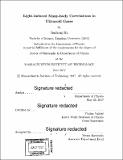Light-induced many-body correlations in ultracold gases
Author(s)
Hu, Jiazhong, Ph. D. Massachusetts Institute of Technology
DownloadFull printable version (16.16Mb)
Other Contributors
Massachusetts Institute of Technology. Department of Physics.
Advisor
Vladan Vuletić.
Terms of use
Metadata
Show full item recordAbstract
In this thesis, we investigate several methods to generate and probe the quantum correlations in ultracold gases using light. A high-finesse optical cavity is used to enhance the atom-light interaction and we can produce a variety of entangled states which can overcome the standard quantum limit. The quantum correlations are generated by sending very weak light into the cavity which contains many neutral atoms. We control the properties of the incoming photon, such as the polarization and/or the frequency spectrum, to obtain the final atomic states as desired. The photon transmitted through the cavity interacts with the atomic ensemble and becomes entangled with the atomic state. The amount of entanglement strength is usually small but non-zero. Placing a detector after the cavity, the tiny amount of entanglement will be dramatically amplified once a photon is heralded in the detector. Using this method, we demonstrated the first observation of the negative Wigner function in the many-body system, and largely extended the record of the maximum number of atoms entangled. Other than engineering entangled many-body system, we have also worked on reaching the quantum degenerate regime for the atomic gas, in order to enhance quantum correlations in future experiments. Laser cooling all the way to Bose-Einstein condensation of an alkali atom is experimentally realized for the first time. We demonstrate a special technique suppressing the binary atomic loss at high atomic density. By transferring the atoms between two different optical traps, the atomic cloud is compressed and the density is increased. Combining these with the Raman sideband cooling method, we achieve the phase space density over 1, and observe the bimodal velocity distribution characteristic of a Bose-Einstein condensate.
Description
Thesis: Ph. D., Massachusetts Institute of Technology, Department of Physics, 2017. Cataloged from PDF version of thesis. Includes bibliographical references (pages 137-149).
Date issued
2017Department
Massachusetts Institute of Technology. Department of PhysicsPublisher
Massachusetts Institute of Technology
Keywords
Physics.